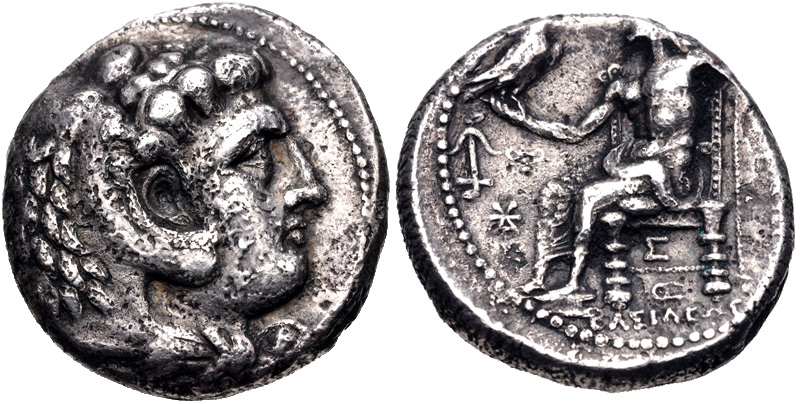Susa (Seleucus I), silver, tetradrachms (Heracles/seated Zeus) (311-305 BCE)
From SILVER
311 BCE - 305 BCE Silver 13,082 kg
Description
| ObverseInscription or printing placed on the obverse.: | Head of Herakles right, wearing lion skin |
| ReverseInscription or printing placed on the reverse.: | ΑΛΕΞΑΝΔΡΟΥ - BAΣΙΛΕΩΣ (Greek).Zeus Aëtophoros seated left, anchor and kantharos in left field above monogram, Σ above strut of throne, ΘΕ below |
Mint and issuing power
| MintIdentifies the place of manufacture or issue of a numismatic object.: | Susa | Ancient regionAncient region.: | Mesopotamia | Modern countryModern country: Iran | AuthorityIdentifies the issuing power. The authority can be "pretended" when the name or the portrait of X is on the coin but he/she was not the issuing power. It can also be "uncertain" when there is no mention of X on the coin but he/she was the issuing power according to the historical sources: | Seleucid Dynasty (312-63 BC), Seleucus I Nicator (satrap in 321-305 BC and Seleucid king in 305-281 BC), Alexander III the Great (Argead king, 336-323 BC) |
Chronology
| FromIdentifies the initial date in a range assigned in a numismatic context. | 311 BCE | toIdentifies the final date in a range assigned in a numismatic context.. | 305 BCE | PeriodTime period of the numismatic object.: Hellenistic 323-30 BC |
Physical description
| MetalThe physical material (usually metal) from which an object is made.: | Silver |
Median weightMedian of the weights of numismatic objects (in grams). in grams | 17.10 | DenominationTerm indicating the value of a numismatic object. Examples: tetradrachm, chalkous, denarius.: | tetradrachm |
StandardStandard.: | Attic |
Image

S2041 Susa Seleucus I alexander.jpg [1]
References
| Die study referencePublication of the study: | Kritt 19971Kritt 1997, p. 5-10 | ||
| Coin series referenceReference to coin series study: | ESM2ESM, n° 284, Price 19913Price 1991, n° 3863, SC I4SC I, n° 164, HGC 95HGC 9, n° 10 | ||
| Coin series web referenceCoin series web references: | |||
Obverse dies distribution
| FrequencyFrequency of specimen in distribution. ᵖ | Number of obversesNumber of obverse dies. ᵖ (o) | % (o) | Number of coinsNumber of coins. (n) | % (n) | Die nameName(s) of the die(s). |
| 1 | 12 | 48 | 12 | 22.22 | 3, 5, 6, 9, 10, 11, 15, 17, 18, 19, 23, 24 |
| 2 | 6 | 24 | 12 | 22.22 | 1, 4, 7, 8, 12, 14 |
| 3 | 3 | 12 | 9 | 16.67 | 2, 22, 25 |
| 4 | 1 | 4 | 4 | 7.41 | 13 |
| 5 | 2 | 8 | 10 | 18.52 | 20, 21 |
| 7 | 1 | 4 | 7 | 12.96 | 16 |
| Total | 25 of 25 | 100 | 54 of 54 | 100 |
Reverse dies distribution
no distribution is available
Quantification
| Number of obversesNumber of obverse dies. ᵖ (o) | 25 | Number of singletons (o1)The number of singleton coins. ᵖ | 12 |
| Number of reverse diesNumber of reverse dies. (r) | 44 | Number of coinsNumber of coins. (n) | 54 |
| Coins per obverse dieNumber of coins per obverse die. (n/o) | 2.16 | Coins per reverse dieNumber of coins per reverse die. (n/r) | 1.23 |
| Reverse per obverse ratioRatio of obverse dies divided by reverse dies. (r/o) | 1.76 | Percentage of singletons (o1)number of coins (n) divided by the number of singletons (o1) ᵖ | 48 % |
| Original number of dies (O) (Carter 1983 formula)The estimation of the number of coins according to Carter 1983 ᵖ | 38.25 | Coins struck if 20,000 as average productivity per dieCoins made if the average productivity for obverses (according to Carter) is 20,000. ᵖ | 765,000 |
| Original number of dies (O) (Esty 2011 formula)The estimation of the number of coins according to the singleton formula in Esty 2011 ᵖ (O) | 46.55 | Survival rate if 20,000 as average productivity per dieSurvival rate if average productivity is 20,000. ᵖ | 0.00007 |
| Coverage (o = % of O) (Esty 1984 formula)Esty 1984 - coverage (% of O) ᵖ (o = % of O) | 77.78% | Die productivity if survival rate 1/2,000Average productivity if survival rate is 1/2,000. ᵖ | 2,823.53 |
| Weight of silver (in kg) if 20,000 coins per die (O = Carter formula)Carter 1983 * Median weight * 20000 (*10 if gold or electrum) ᵖ | 13,082 kg <br /> 13,082 kg | Die productivity if survival rate 1/5,000Average productivity if survival rate is 1/5,000. ᵖ | 7,058.82 |
Remarks
Most likely one single workstation Likely military
References
- ^ Kritt, Brian (1997), The Early Seleucid Mint of Susa, Lancaster, xviii, 202 p.
- ^ Newell, Edawrd T. (1938), The coinage of the eastern Seleucid mints, from Seleucus I to Antiochus III, Numismatic Studies 1, New York, 307 p., LVI pl.
- ^ Price, Martin Jessop (1991), The Coinage in the Name of Alexander the Great and Philip Arrhidaeus: a British Museum Catalogue, 2 vol., Zürich-London, 637 p., 637 p., clix pl.
- ^ Houghton, Arthur - Lorber, Catharine (2002), Seleucid coins : a comprehensive catalogue. Part 1, Seleucus I through Antiochus III, New York - Lancaster - London, 2 v. (xxxviii, 488 p. + 300 p.), 101 pl.
- ^ Hoover, Oliver D. (2009), Handbook of ancient Syrian coins : royal and civic issues, fourth to first centuries BC, The Handbook of Greek Coinage 9, Lancaster, lxix, 332 p.